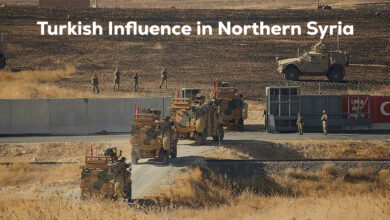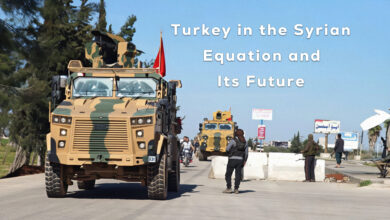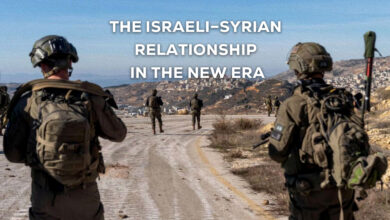The Projects planned by Regional and International powers in the Middle East and Syria

We can consider the Middle East and North Africa as some of the most important geographical regions that can control global routes and connection hubs; they essentially control many waterways and airways in addition to the vast land area available for investment in land roads and railways to connect the world. Geographically, Syria can be considered one of the most important parts of this geography, and therefore, it has always been the central axis in all geopolitical and economic projects planned for this region, due to its strategic and geopolitical importance. Thus, after the outbreak of what became known as the Arab Spring, which began at the end of 2010 in Tunisia and extended to Libya, Egypt, Yemen, and eventually Syria, it was imperative for regional and international powers to be aware of the potential for widespread chaos in the region and to focus on the possibility of maintaining stability and preserving international interests and global trade routes and corridors.
Some existing routes and corridors, along with planned projects in the Middle East:
Suez Canal: Undoubtedly, we can consider the Egyptian Suez Canal as the most important connection project between the East and West; it is man-made, and its significance lies in saving a lot of time and duration, as well as in saving money and costs in transporting goods. Thus, in addition to being a tourist income source for Egypt, it is considered one of the most important sources of foreign currency income for Egypt and plays an important role in shaping Egypt’s general policies and how it interacts with others; this is achieved by benefiting from its geopolitical and strategic position, in addition to making Egypt one of the pivotal countries in the Middle East and North Africa. Consequently, it allows Egypt to play a major role in shaping regional policies and the possibility of being relied upon in that.
Ben Gurion Canal or Israeli Canal Project: This is a proposed project for a waterway that aims to connect the Gulf of Aqaba with the Mediterranean Sea. Its implementation scope in the short or medium term is unclear; however, it is a project that already exists in Israeli plans that rely on a far-reaching strategic perspective. The canal is presented as a competitor or parallel to the Egyptian Suez Canal.
The Belt and Road Initiative (Chinese Silk Roads): virtually, this is not just a single road; rather, it consists of several interconnected routes that form a huge network of roads, which, in turn, creates a kind of smoothness and prevents traffic and commercial congestion. The Belt and Road Initiative can be considered a modernization of the old Silk Roads, in addition to creating new routes and corridors that keep pace with the rapid developments happening in the world, through land, sea, and air routes, with a focus on a connected railway network.
The Spice Route Project (the Indian Spice Route) is a trade route connecting the civilizations and continents of the ancient world from Southeast Asia, passing through the Middle East and the Horn of Africa to Europe. It focused on the trade of various spices and was named because India produces approximately 75% of the world’s spice output. Today, India ranks fifth globally among the strongest economies, and because it is adjacent to China and a strong competitor, especially after achieving growth rates of 9% in 2022, it has become a target for Western countries, led by the United States, to create economic partnerships with it. Thus, it is an old yet renewed project, announced for renewal or modernization at the 18th summit of the G20 in New Delhi, India, in September 2023, with an approximate value of nearly 600 billion US dollars. It starts from India to the United Arab Emirates, then to Saudi Arabia, Jordan, Israel, and the European Union.
The Development Road: The Grand Faw Port in Basra, Southeast Iraq, is considered the starting point for the “Development Road” project that will connect Iraq to Europe via Turkey, passing through the provinces of Al-Diwaniyah, Najaf, Karbala, Baghdad, and Mosul. This road is still under discussion and the execution of this idea depends on many international and regional calculations on the ground.
The Iranian Railway Project: This is a strategic Iranian idea and plan to connect the Khomeini Port in Iran with southern Iraqi cities in the areas controlled by the Shiite movement, reaching to the city of Al-Bukamal in Syria and Al-Qaim crossing. From there, it branches out to a line leading to the city of Al-Tanf, then to the Syrian capital Damascus, and then to the Lebanese capital Beirut. The second line reaches through the Syrian desert to the city of Homs and then to the Latakia port on the Syrian coast. However, according to the current scene, especially after the fall of the Syrian regime, it seems that this project has been stillborn even before its inception.
The North-South Corridor: A network of land roads and railways allowing Russian goods to reach the Indian Ocean and vice versa. The project’s idea primarily arose from the need following Western sanctions on Russia, thus bringing it closer and enhancing its relations with Iran for mutual geographical and political benefits. This project meets Russia’s constant need to reach warm waters. An agreement was reached regarding the establishment of the North-South transport corridor at the second Eurasian international transport conference, held in St. Petersburg in September 2000, where a trilateral agreement was signed between Russia, Iran, and India.
The existing roads and future projects in Syria:
As previously mentioned, Syria’s geopolitical and strategic location holds great significance for regional and international powers. Consequently, with the outbreak of events in 2011 and the beginning of peaceful movements, one of the primary objectives for the active forces has been to exploit its geography, particularly in implementing projects related to creating a network of international roads and corridors, making it a junction. The most important international overland routes in Syria include:
– The International Road or Silk Road (M42): This road connects the port of Latakia to the Iraqi border and is considered important from both strategic and economic perspectives for Syria, Iran, Iraq, and China. It can be used for transporting goods and products, implying that the road plays a role in linking the Iranian axis and enhances Iranian military influence, as well as boosting Chinese economic influence; this creates a nexus of a Chinese-Iranian alliance if Iran becomes a gateway for Chinese expansion towards the Mediterranean.
– The International Road (M4): This route extends from the border with Iraq to the city of Latakia on the Mediterranean coast. Its strategic importance arises from being a crucial link between the most important regions in Syria: the northern and northeastern area and the western and northwestern region. It is considered a vital artery for trade and the economy in Syria, connecting key industrial and commercial areas within Syria, such as Aleppo, Hama, Homs, and the coast, with regions that contain raw materials from agricultural and animal products in northern and eastern Syria. Therefore, this road is regarded as the main supply line for goods and products between these areas, linking Syria’s maritime gateway on the Mediterranean with the internal regions.
– The International Road (M5): This road is 450 kilometers long and extends from the Nasib crossing on the border with Jordan to the Bab al-Salama and Bab al-Hawa crossings on the border with Turkey, passing through major cities such as Daraa, Damascus, Homs, Hama, and Aleppo. North of Homs, it connects with the international road leading between Homs and the Syrian coast, passing through the cities of Tartus, then Baniyas, then Jableh, eventually reaching Latakia. In the capital Damascus, it intersects with the international road connecting to neighboring Lebanon. The strategic importance of this road internationally lies in its being a corridor for land trade between Europe and the Arabian Gulf.
In addition to these existing roads, there are some ongoing projects and plans; among them are:
– The Arab gas pipeline: includes Egypt, Jordan, and Syria. The pipeline project began as part of bilateral dialogue between Egypt and Jordan in 2001, and later Syria and Lebanon joined the memorandum of understanding. Israel, Turkey, and Iraq also signed agreements to cooperate on the trans-regional pipeline project. As planned, the pipeline was expected to have economic significance not only for the Arab region but also for Europe, Asia, and Africa. Both the U.S. and the Western bloc support this project as it competes with the Eastern bloc and represents a form of indirect normalization with the allied Israel. Consequently, the Eastern bloc, represented by Russia and Iran, opposes this project due to its direct impact on their economic and geopolitical interests.
– The Qatari-Turkish gas pipeline: It is a Qatari proposal to build a natural gas pipeline through Saudi Arabia, Jordan, and Syria. From Syria, the pipeline branches into three routes: one to Tripoli in Lebanon, one to Latakia in Syria, and the third to Turkey. The goal of the pipeline was to connect Qatar directly to European energy markets. However, Syria refused in 2009 to allow the pipeline to pass through its territory, leading to the project’s failure. The reasons for the refusal were related to the nature of Syrian-Iranian relations, concerns that it would enhance Saudi influence in Syria, maintaining relations with Russia, and blocking Gulf competition in European markets against Russian gas.
– The Iranian gas pipeline: The Iranian Islamic pipeline extends from the Iranian side of the gas field in the Arabian Gulf, passing through Iraq into Syria, and then branches into three routes from Homs: towards Latakia, Turkey, and the ports of Lebanon. The primary objective of this project is to serve as an alternative to the Qatari project, as well as to pump Iranian gas to Europe, enhance Iran’s geopolitical and economic position, and circumvent Western sanctions.
– The Kirkuk-Banias gas pipeline: This line is considered to be somewhat an old-new project because it originally started with the development of the regional energy transport system in 1952 in the Middle East. The construction of the crude oil pipeline from the Kirkuk oil field in Iraq to the Syrian port of Banias was completed, but operations stopped due to geopolitical changes in the region starting from the Iraqi regime change in 2003 to the Syrian regime change at the end of the previous year.
There is no doubt that most conflicts and disputes carry an economic core within them, and what has happened and is happening in Syria is clear proof of that. For instance, Russia and Iran’s direct involvement in Syria was primarily to protect their interests and benefit from Syria and its geography. The previous regime was merely a tool to implement their agendas. Even after fourteen years of support, it was abandoned once its role in the international political game and interest sharing concluded. We can apply this understanding to the current situation on the ground by identifying the beneficiaries and losers in the ongoing events, thus allowing us to analyze what may happen in the coming days. The current authority, as it seems, may not meet the expectations regarding the future aspirations of the Syrian people.




